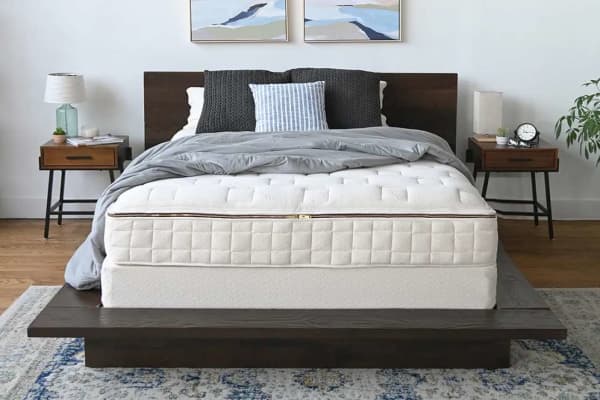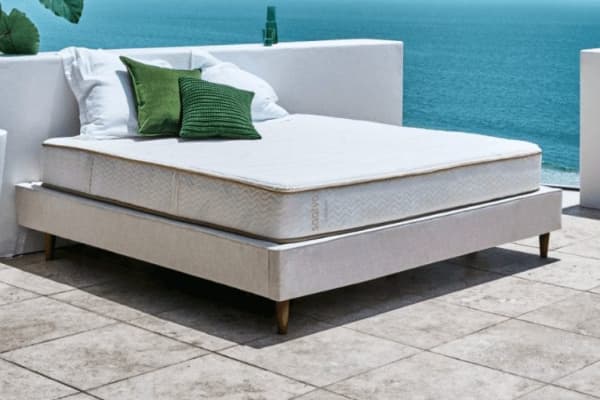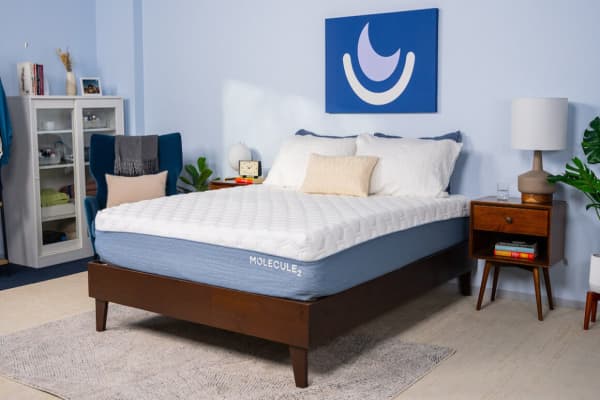Allergy symptoms such as sneezing, nasal congestion, and difficulty breathing can interfere with getting a good night’s rest. Common offenders like dust mites, mold, and pet dander can accumulate inside mattresses and bedding, affecting sleep in the process. The good news is that some mattresses are specifically designed to resist allergen buildup.
We’ll discuss tips for choosing a mattress that can reduce the severity of allergy symptoms. We’ll also highlight our top picks for allergy-friendly mattresses so you can find the best fit for your sleep style.
Find Your Perfect Mattress
We know mattresses work differently for different types of sleepers. Use the filters below to help narrow down your options for your best bed.
Read on to see why the following five options made our top picks list of 2024’s best mattresses for allergies.
Sleep Doctor’s Picks
Best Overall
Birch Mattress
Sleep Doctor’s Review
The Birch Mattress features a latex and coil design topped with cotton and wool layers to cushion your body. All the materials are known for their breathability, so we highly recommend this model for hot sleepers.
Buy From HelixHot Sleepers
Medium Firm (6)
Great Airflow
eco-INSTITUT
Pros
- Breathable natural and organic materials
- A responsive latex and wool comfort system
- Free shipping to all 50 states
Cons
- Some sleepers may find the bed too responsive
- Stomach sleepers over 230 pounds may need a firmer bed
- Couples may prefer a model with stronger motion isolation
Why We Like It
Constructed from natural and organic materials, the Birch Mattress is ideal for eco-conscious shoppers with allergies who also tend to sleep hot. Our testers found that the layers of cotton, wool, and latex increased the mattress’ breathability while resisting allergen buildup. The hybrid model merges pocketed coils with Talalay latex for responsive support, and a medium firm (6) feel made the mattress suitable for all of our testers, regardless of weight.
A stretchy and breathable GOTS-certified organic cotton cover encases the mattress. A blend of organic wool and rayon below serves as a natural fire barrier, while an additional wool layer cushions sleepers. Our testing team liked that the layer of natural Talalay latex balanced contouring with responsiveness. The latex is certified by the eco-INSTITUT, indicating that it meets rigorous standards concerning chemical emissions.
How Does It Feel?
We noticed that the pocketed coil core gave the mattress bounce without generating significant motion transfer. The individually wrapped coils promote airflow, which our testers found helped the mattress stay cool. Sturdier coils reinforce the perimeter, providing robust edge support that allowed our testers to use more of the mattress’ surface. A wool-rayon blend layer completes the mattress, acting as an additional flame barrier.
With organic materials and a medium firm (6) feel, the Birch suits a wide range of sleepers looking for a sustainably made mattress designed to minimize allergens.
Most Comfortable
Naturepedic EOS Classic
Sleep Doctor’s Review
The Naturepedic EOS Classic is one of the most customizable hybrids we’ve ever tested. The latex and coil model is available in five firmness levels with the option to customize firmness for each side of the bed. We recommend this bed for co-sleepers who have different comfort preferences.
Buy From NaturepedicCouples
Medium Soft (4), Medium (5), Medium Firm (6), Firm (7), Firm (8)
Great Airflow
GREENGUARD, Global Organic Textile Standard (GOTS)
Pros
- Interchangeable layers
- Latex and coil layers available in different firmness levels
- GOLS and GOTS certification
Cons
- Above-average price-point
- Latex and coils produce some motion transfer
- Sleepers with painful pressure points may prefer a plusher surface
Why We Like It
The Naturepedic EOS Classic is a latex hybrid mattress with standout customizability features. You can configure the bed into five different firmness options and may also customize different configurations for each side of the bed.
The mattress contains a cotton cover quilted with wool batting and a plant-based PLA material, a 3-inch organic latex layer, an 8-inch layer of pocketed coils, and organic cotton batting. The latex and coil layers each come in different firmness levels and you can place these layers in whichever order feels most comfortable. Depending on which firmness layers you choose and how you order the layers, your firmness options are medium soft (4), medium (5), medium firm (6), firm (7), and firm (8).
How Does It Feel?
Thanks to the excellent customization options, the EOS Classic is suitable for a wide variety of sleep positions and body weights. During testing, stomach sleepers felt most comfortable on firmer configurations. Side sleepers preferred options with more cushioning to help relieve pressure in the shoulders and hips, and back sleepers were most satisfied with medium firm to firm options. Those over 230 pounds felt more comfortable on the firm configurations.
Our tests showed that the EOS Classic sleeps exceptionally cool. This is due in large part to the natural cooling properties of latex and strong ventilation through the coils. The mattress has GREENGUARD certification to ensure low chemical emissions and the latex and cotton are GOLS- and GOTS-certified, respectively, to show that the bed has organic sourcing.
Best Luxury
Zenhaven
Sleep Doctor’s Review
The Zenhaven is an all-latex model with a flippable design that provides a different firmness level on each side of the mattress. Most testers on our team found a side that suited their sleep position and personal preferences.
Buy From SaatvaHot Sleepers
Medium Soft (4), Firm (7)
Great Airflow
Global Organic Textile Standard (GOTS)
Pros
- Reversible design with two firmness levels
- Zoned natural latex for targeted support
- Heat-wicking organic wool and cotton layers
Cons
- May be too thin for sleepers who prefer high-profile beds
- Latex transfers some motion across the surface
- Above-average price-point
Why We Like It
Saatva’s Zenhaven is a natural latex mattress designed to repel everyday allergens like dust mites, mold, and dander. The latex undergoes a special process to remove proteins that typically trigger symptoms. The Zenhaven is also free of harsh chemicals and dyes.
Latex is known to be resilient, and our testing indicated the Zenhaven is a durable mattress. Additionally, our testers noticed the mattress had minimal off-gassing, meaning it doesn’t produce much of the smell commonly associated with memory foam mattresses right after unboxing.
The mattress also has Rainforest Alliance certification, showing that the latex used in its construction was sourced according to strict environmental and social standards.
How Does It Feel
The flippable design offers two different firmness levels: medium soft (4) and firm (7). A GOTS-certified organic cotton cover is designed to draw heat away from your body. The cover is treated with Saatva’s Guardin, a nontoxic treatment intended to reduce microbial growth. A 1-inch layer of organic wool on each side functions as a natural fire barrier.
Both sides use Dunlop latex with small perforations designed to promote airflow. The comfort layers are divided into five zones, which our testers noticed offered targeted support to their backs and midsections. The medium soft side offers deeper contouring, which suited most of our side-sleeping testers. An additional layer of firm Dunlop latex on the reverse side creates a sturdier feel that better suited our back and stomach sleepers.
Best Pressure Relief
Nolah Natural 11
Sleep Doctor’s Review
The Nolah Natural 11’s latex layers and coil core are well-suited to sleepers who need solid support with gentle cradling on the surface. Most testers on our team found this comfortable, regardless of their sleep position.
Buy From NolahHot Sleepers
Medium Firm (6)
Great Airflow
Global Organic Textile Standard (GOTS)
Pros
- Heat-wicking organic wool cover
- Excellent temperature control
- Contouring yet responsive latex comfort system
Cons
- Produces some motion transfer
- 11-inch profile may be too thin for some sleepers
- Side sleepers with sharp pressure points may need deeper contouring
Why We Like It
Blending responsive latex with a pocketed coil core, the Nolah Natural 11 addresses vulnerable pressure points on the spine, hips, and shoulders. The Talalay latex comfort system contours your body while still providing a responsive feel. With an 11-inch profile and a balanced medium firm (6) feel, the hybrid mattress performed well for all of our testers regardless of body size or sleep position.
The mattress is topped with breathable layers of GOTS-certified organic wool and cotton. This means that an official body has reviewed the supply chain to make sure the process is actually organic, according to professional standards. The mattress also has Rainforest Alliance certifications, indicating that it meets strict content and environmental guidelines.
How Does It Feel?
Our testers reported that the 2-inch layer of natural Talalay latex conformed to their bodies, providing standout pressure relief. A 1-inch layer of transitional Talalay latex supported spinal alignment, helping to prevent aches and pains.
Nolah’s HDMax Tri-Zone coiled core is zoned, which gave our testers targeted support and minimized sinkage. The coils are individually wrapped and lined with cotton and wool to increase breathability.
With excellent pressure-relieving abilities and a medium firm (6) feel, the Nolah Mattress suits a wide range of sleepers looking for a foam bed that contours to the body and sleeps cool. Its certified materials also make it less likely to collect allergens and exacerbate allergy symptoms.
Best Cooling
Molecule 2 AirTEC Mattress
Sleep Doctor’s Review
The all-foam design of the Molecule 2 AirTEC Mattress caters to sleepers who need strong cushioning for sensitive joints. The bed earned the highest marks from our side-sleeping testers, who enjoy beds that cradle the shoulders and hips.
Buy From MolelculeCombination Sleepers
Medium Firm (6)
Some Airflow
CertiPUR-US
Pros
- Specialized foam layers promote airflow and help the mattress sleep cool
- Transitional layer is zoned to reinforce the midsection and cradle lighter areas of the body
- Microban treatment helps safeguard the mattress from contaminants
Cons
- Less edge support than a hybrid or latex model
- Foam surface may inhibit easy movement
- Foam may retain too much heat for sleepers who run very hot
Why We Like It
The Molecule 2 AirTEC is equipped with cooling features that set the mattress apart from other all-foam models, many of which trap and store heat to a bothersome degree. The topmost foam layer is infused with crystals intended to dissipate body heat from the surface. We noticed that the cover, made from a breathable poly-spandex blend, worked well with the ventilated comfort layer and convoluted transitional layer to promote airflow throughout the interior of the mattress. This helped keep our testers cool.
For hot sleepers who find it difficult to sleep comfortably on other all-foam mattresses, the Molecule 2 AirTEC provides a supportive sleep surface that includes technologies designed to prevent allergen and bacterial buildup.
How Does It Feel?
The Molecule 2 AirTEC’s medium firm (6) feel ensured light cushioning and even support for most of our side and back sleepers. During our tests, the mattress felt most comfortable to side sleepers weighing more than 130 pounds and back sleepers weighing up to 230 pounds.
The transitional layer is zoned to feel firmer beneath the torso and hips, and gentler around the head, shoulders, and legs. This feature allowed our side-sleeping testers to lie comfortably without feeling too much pressure in the shoulders and hips, while our back-sleeping testers noticed minimal sinkage around their midsections.
All Molecule 2 AirTEC models are given a Microban treatment during production. This antimicrobial agent is engineered to minimize growth of bacteria, mold, mildew, and other contaminants that can trigger allergy symptoms and make your sleep surface less hygienic.
Why You Should Trust Us
We take a holistic approach to sleep products, testing a wide variety of models to accommodate varying sleep preferences and budgets. Beyond allergy-friendly designs, we evaluate other key performance metrics such as pressure relief, support, and temperature control so you can find a mattress that fits your needs and rates well across a range of categories, including allergy relief.
More Mattress Options for Specific Needs
What Mattress Type Is Best for Allergies?
While no single mattress model is guaranteed to alleviate all allergy symptoms, some materials and construction methods are less likely to trap common allergens like dust mites, mold, and mildew.
Foam Mattresses
In a foam mattress, different types of foam may be used to balance contouring with support. Comfort layers often incorporate memory foam since it closely conforms to the body, while support cores often include high-density polyfoam to stabilize the mattress. Foam mattresses excel at pressure relief and motion isolation and tend to have affordable price-points.
Many types of foam are allergy-resistant, especially high-density varieties that leave little space for dust mites and other allergens to flourish. Memory foam also tends to be resistant to the buildup of common allergens.
Hybrid Mattresses
A hybrid mattress integrates a coiled support core with thick comfort layers made from foam, latex, or a combination of the two. By combining different construction methods, hybrids offer a balance of pressure relief and bounce. Hybrids may also include various cooling technologies to minimize heat retention.
Many hybrids have latex or memory foam comfort layers, which are both generally considered allergy-resistant. Additionally, some covers and surfaces undergo treatments designed to reduce the buildup of dust mites, mildew, and mold.
What About Innerspring Mattresses?
Today, hybrid models are more common than innersprings. Some bedding companies use the terms innerspring and hybrid interchangeably, but there are meaningful differences between the two mattress types. Innersprings have minimal comfort layers and open coils, while hybrids use substantial comfort systems and pocketed springs. Hybrids also usually provide better support, contouring, and motion isolation over innersprings.
People with allergies should be cautious when considering an innerspring mattress, as fiber padding can harbor dust mites and bacteria. Furthermore, innerspring construction can lack optimal support and pressure relief.
Latex Mattresses
This type of mattress is made exclusively from latex and may be either natural or synthetic. Natural latex is sourced from the sap of rubber trees and can be formulated into Dunlop or Talalay latex. Dunlop is dense and long-lasting, while Talalay has a more responsive feel.
Latex contours the body without causing too much sinkage, so sleepers shouldn’t feel trapped in their mattress. Since latex is naturally breathable, mold and mildew are less likely to develop. Its denser structure also makes it more resistant to dust mites and other allergens.
While some people have latex allergies, its occurrence is rare. Still, many manufacturers use a process that removes the proteins in latex that cause allergy symptoms.
How to Sleep Better With Allergies
Allergy symptoms such as congestion, coughing, sneezing, and itching can disrupt sleep and even cause insomnia. Allergies that obstruct your airflow may lead to snoring and sleep apnea — two factors that can reduce sleep quality.
Sleep is essential to your health and wellbeing, but many people with chronic allergies have difficulty feeling refreshed in the morning. Side effects of interrupted sleep include irritability and diminished work performance.
Along with finding the right type of mattress, there are some additional practices that can minimize allergy symptoms and help you get a good night’s rest.
Sleep on Your Side
People with allergies sometimes struggle to keep their airways open, which can contribute to snoring and sleep apnea. Side sleeping is the best position for maintaining open airways, whereas sleeping on your back can worsen air obstructions.
In order to promote good neck and spinal alignment, side sleepers benefit most from a thicker pillow that slightly elevates the head. Raising the head can also improve congestion since mucus is less likely to stagnate.
Prop Your Head Up
If you’re a committed back sleeper and can’t adjust to side sleeping, propping your head up can still be beneficial. Raising your head drains nasal congestion, which can improve respiratory allergy symptoms. Back sleepers should use a medium loft pillow that elevates the head without thrusting the neck forward too much.
Try an Air Filter
Many people with allergies find relief by using air filters that can remove considerable amounts of pollen, dust, mold, and pet dander from their sleep environment. High-efficiency particulate air (HEPA) filters are particularly effective at attracting and filtering out irritants. To get the most out of your purifier, make sure to regularly clean and replace the filters.
Sleep Without Pets
Even if you’re not allergic to pets, separating yourself from your furry friend at night can curtail unpleasant allergy symptoms. Animals produce pet dander, which is a significant trigger for many sleepers. Fur also attracts a number of other contaminants like dust mites and mold, so keeping pets out of the bedroom can decrease your irritant load.
Keep Your Bedding Clean
Avoiding unpleasant allergy symptoms requires more attentive cleaning, but the payoff is well worth the extra effort. Washing your sheets weekly can reduce irritants like dust mites and pollen, as well as dirt and sweat. Using hot water has been shown to be the most effective way to remove allergens. Vacuuming your mattress’ surface every one to two months can also remove potential triggers.
Similarly, getting into the habit of bathing before bedtime can prevent unwanted contaminants from entering your bed.
Look Into Hypoallergenic Bedding
Bedding Type | Properties |
|---|---|
Sheets and Pillowcases | Sheets and pillowcases made from natural materials like cotton, silk, and wool are usually the most breathable and the most friendly to people with allergies. Synthetic materials sometimes contain harsh chemicals and dyes that can trigger adverse reactions. Products labeled hypoallergenic are usually safe. |
Pillows | Memory foam or latex pillows are good choices for allergy sufferers because their dense construction hinders contaminant growth. Pillows made from down and feathers are usually the worst offenders when it comes to provoking allergy symptoms. If you’re sensitive to these materials, choose a hypoallergenic alternative designed to offer a comparable loft and feel. |
Duvets and Comforters | Similar to sheets and pillows, duvets and comforters constructed from natural materials are typically the least likely to trigger unpleasant allergy symptoms. It’s best to avoid bedding with loose weaves, as they’re more likely to harbor dust mites and other allergens. |
What About Mattress Covers?
A mattress cover is a helpful alternative if you’re not able to replace your current mattress with a more allergy-friendly model. Mattress covers can reduce triggers by creating an extra barrier between sleepers and any irritants in a bed.
Covers are best used as a short-term solution, however, as their ability to alleviate allergy symptoms is somewhat limited.
Talk to Your Doctor
Pesky allergy symptoms can sometimes persist even after making changes to your bedroom environment. Consult with a medical professional if your allergies continue to negatively impact your sleep.
Ask the Sleep Doctor
Have questions about sleep? Submit them here! We use your questions to help us decide topics for articles, videos, and newsletters. We try to answer as many questions as possible. You can also send us an email. Please note, we cannot provide specific medical advice, and always recommend you contact your doctor for any medical matters.







